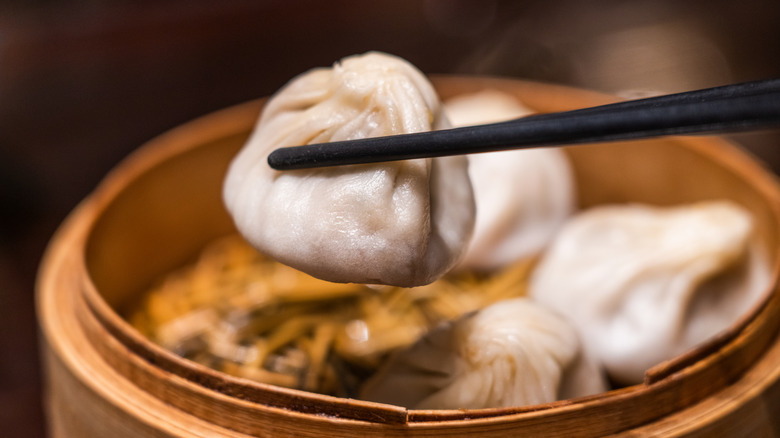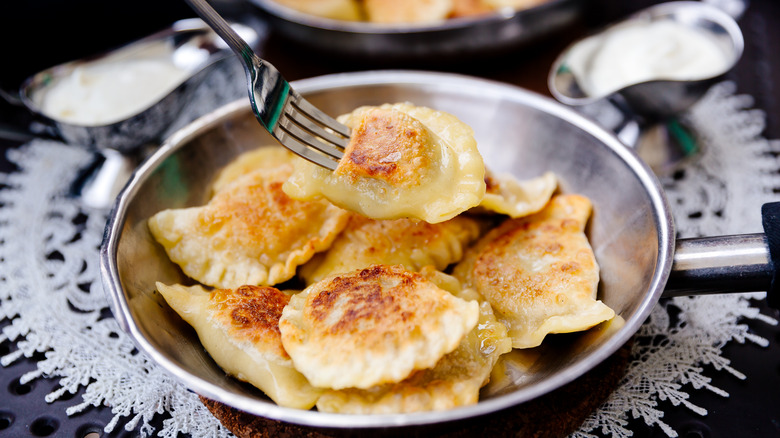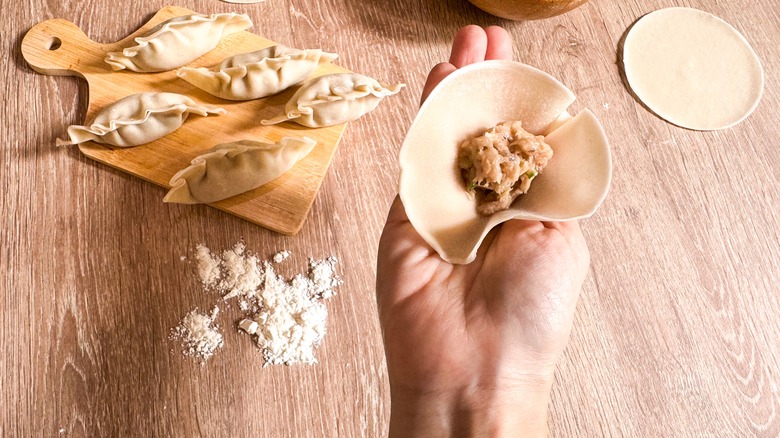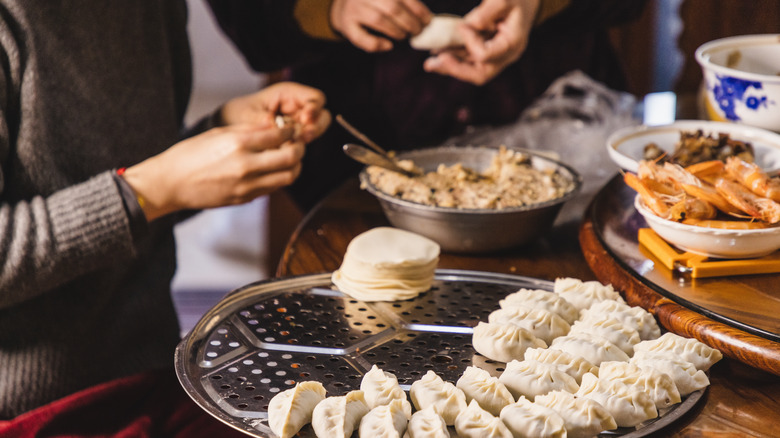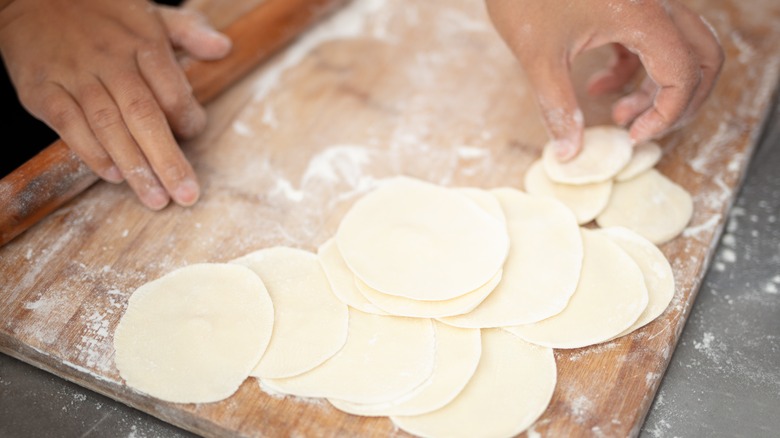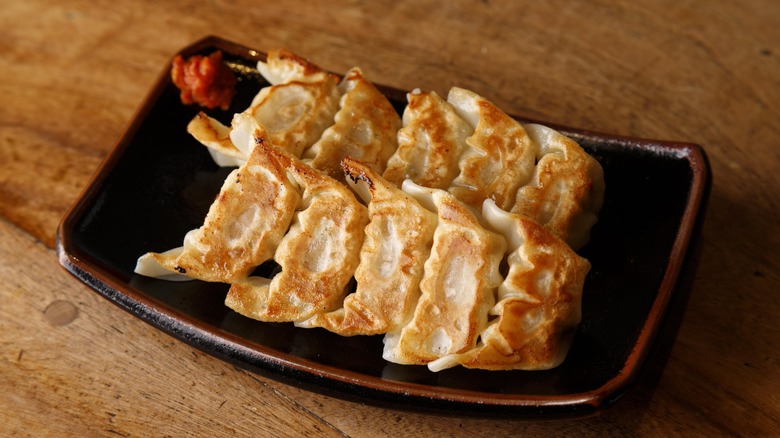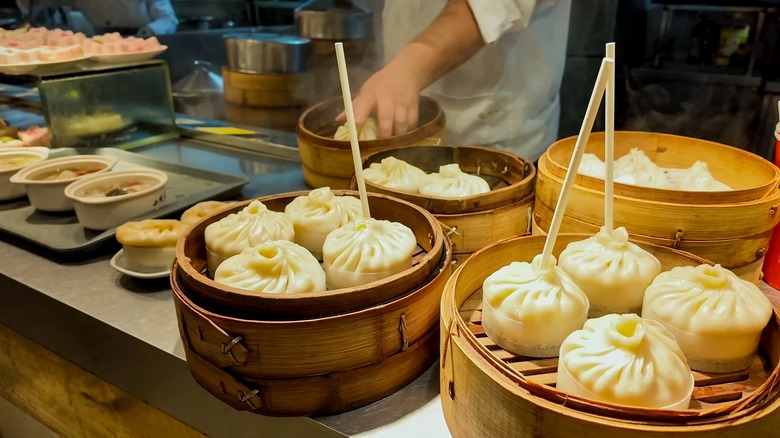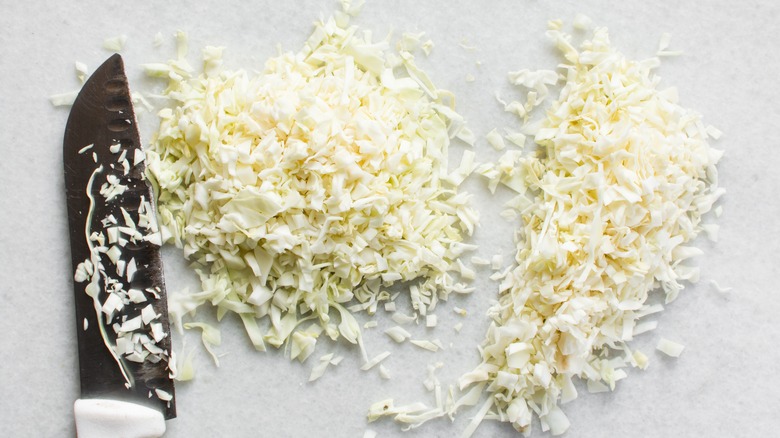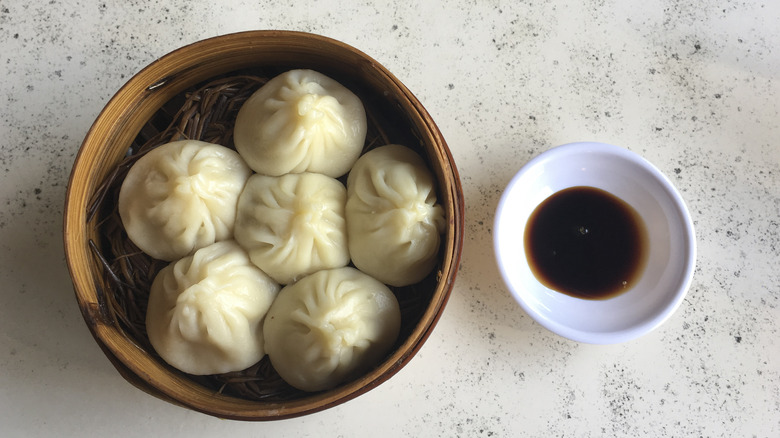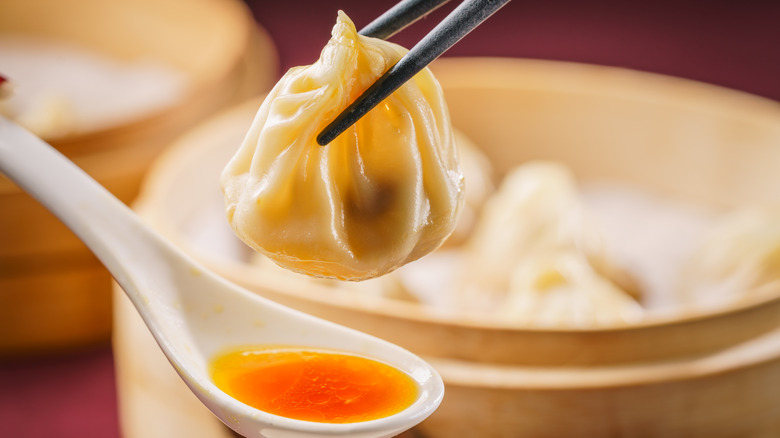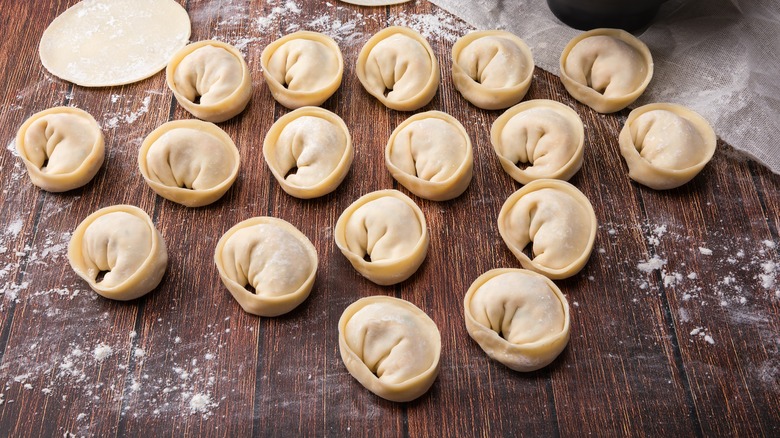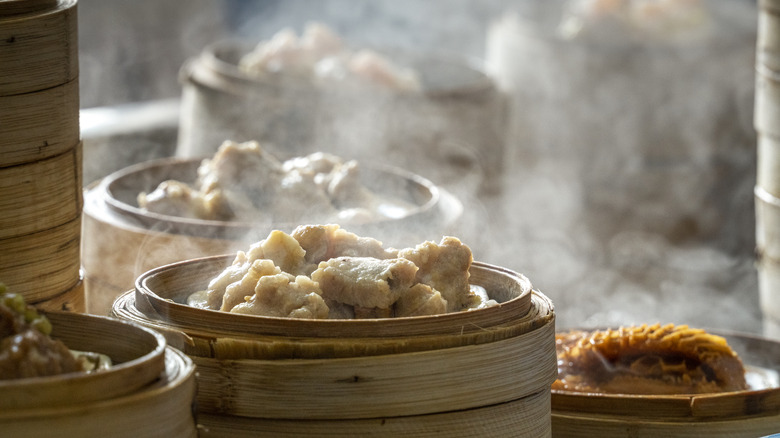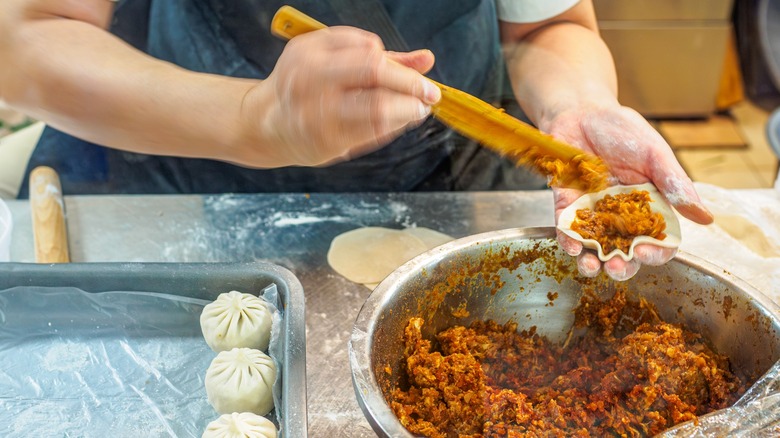Here's Why Dumplings Are Always Better At A Restaurant
Dumplings are arguably one of the greatest food groups. Everything from bao to gyoza to pierogies come under the umbrella, and we're here for it. But why is it that dumplings are always better at a restaurant? When you try to make them at home, they can turn out soggy, falling apart, overly stodgy, or just underwhelming.
Of course, when you buy dumplings from a restaurant, they're made by professionals who may have decades of experience whipping them up. But it's more than just that. We're about to investigate the secrets behind restaurant-quality dumplings, looking at all the reasons why they're just better. Sure, you might be able to make pretty good dumplings yourself at home, but they never seem to reach the heights of those bought from your favorite spot.
Once you understand what makes restaurant dumplings better, you can use these techniques yourself at home to up your game. However, you can't magic up the experience that comes with making hundreds of these delicious little parcels every day. When you think about all the effort that goes into getting them perfect, you might decide to hit up your favorite dumpling restaurant instead and save yourself the trouble.
Restaurants often specialize in particular types or styles of dumplings
We're talking about dumplings, but what does that even mean? For these purposes, we're discussing filling dumplings rather than the bready ones you'd get in a stew. However, that's still a huge pool of contenders. Restaurants usually specialize in particular types of dumplings or dumplings from a certain region. This means they can hone their craft rather than trying to perfect every variety.
Many people automatically think about Asian dumplings, but that's still a huge category. There are many types of Chinese dumplings, for starters. But then you also have Japanese dumplings, such as gyoza, and Nepalese and Tibetan momos. Beyond Asia, there are Central and Eastern European dumplings, such as Polish pierogi and colțunași from Moldova. Manti are delicious Turkish dumplings that are served with yogurt. At a stretch, even stuffed pasta like ravioli and tortellini could be considered dumplings.
By specializing in certain types of dumplings, restaurants are able to perfect them. Chefs may come from the regions where the dumplings originate or have been trained in cooking food from the area, thus giving them even more experience and expertise. If you want to improve your home-cooked dumplings, perhaps start with one particular variety before moving onto another.
Chefs know how to keep dumplings from falling apart
When you get dumplings from a restaurant, they're always perfectly formed and in one piece, but when you make them at home, they end up falling apart. What gives? One way professionals keep dumplings together is creating a cohesive filling that sticks to itself.
Ingredients are either chopped extremely finely or blitzed in a food processor to make them easier to handle. When the filling is cohesive, even if you end up with a slight tear in the wrapper, it shouldn't all fall out. The key is to make a filling that sticks together. To test this, grab a handful and squeeze it together. If it stays in a lump, it's the perfect filling consistency. If not, you need to do a bit of work.
The first thing you can try is pulsing it a few times in a food processor, if you haven't done so already. You don't want to make a purée, but you do want the ingredients chopped very finely with a bit of mush to stick everything together. Otherwise, add an ingredient as a binder. Depending on the type of dumpling, this might be mashed beans, mashed potato, blended silken tofu, ricotta, or another similar soft cheese.
Restaurants use quality ingredients, with some sourced from specialty stores
When you get dumplings from a good restaurant, the chefs will have thought carefully about the ingredients used in them, and they'll be made from fresh, high-quality ingredients. It might sound simple, but it's one of the best ways to make great food.
Chefs who care about their craft will think carefully about sourcing ingredients. Where possible, they might even buy from local growers and producers. This kind of care and attention helps produce a world-class dumpling that stands out from basic ones you'll find frozen in a bag.
It's also worth noting that most chefs will use specialty ingredients in dumplings that you might not be able to pick up at the average U.S. grocery store. Although some dumpling wrappers and doughs are made using regular flour, others use specialty versions, such as glutinous rice flour or tapioca flour. And, if a recipe calls for wheat starch, it is worth knowing that this isn't the same as wheat flour — it's had all the gluten removed so only the starch remains.
Some of these ingredients will be sourced from specialty stores, such as Asian grocery stores or eastern European supermarkets, depending on the dumpling type. If you're making dumplings at home and subbing any harder-to-find ingredients with basic things you already have in your pantry, you can't expect identical results.
Dumplings from restaurants may have their wrappers made from scratch
Have you noticed that some restaurant dumplings are just next-level? Well, this might be because their wrappers are made by hand. Not every dumpling spot makes its own wrappers — store-bought ones do the job in most cases — but truly exceptional offerings are often made entirely from scratch.
When the wrappers are handmade, they tend to come out slightly thicker, softer, and more chewy. Sometimes you need the delicate thinness of a store-bought wrapper, but those made from scratch give dumplings a more rustic, homemade feel. They end up like a dish someone's grandma might serve you, rather than being similar to decent frozen dumplings.
Yes, it takes more time to mix and knead the dough — and sometimes you need to wait for it to rise in the case of yeasted dumplings — but the results make it worthwhile. There's a little extra skill involved in rolling out the dough, but it means you get total control over how big and how thick the wrappers are. Plus, they tend to be less of a hassle to work with, less prone to tearing, and easier to seal.
Restaurants have special techniques to give dumplings a crispy bottom
If you love dumplings with a crispy bottom, you might be wondering how to achieve this. We're not talking about fried dumplings, but rather ones that are crispy underneath but have a steamed consistency on top. Restaurants know the techniques needed to achieve this texture. And it might mean you end up preferring these versions to ones you make at home, whether steamed, boiled, or fried.
But, luckily, there's a simple way to give dumplings a crispy bottom. The most straightforward option is to pan fry them in a little oil until they're crisp underneath. Then, you add half a cup or so of water to the skillet, pop the lid on, and let them steam for a few minutes. This should give you the crunchy underside and steamed pop that you're looking for.
However, if this still isn't crispy enough for your liking, there's another technique you can try. You make a thin slurry of flour and water and add it to the oiled pan after frying your dumplings for a bit. This crisps up, creating a crunchy latticed network of deliciousness. You might choose to fully steam your dumplings before adding them to an oiled pan and doing this. That way, you can be sure that they're entirely cooked through.
Professional kitchens have the right equipment for making dumplings
Although having fancy equipment isn't everything, it can make a difference. Professional kitchens have all the right equipment for making dumplings, and this is part of why they turn out better. Of course, it's still no use having all the gear and no idea how to properly make dumplings. But the correct gadgets and knowledge is going to give you better results than having the experience and no equipment.
The tools you need to make dumplings well aren't all that high-tech or pricey, so, if you're committed to learning how to make them perfectly, you can absolutely pick up what you need easily. A dough scraper is a hugely useful and inexpensive piece of equipment to help you bring together and knead your dough. That said, busy professional kitchens are more likely to use a commercial stand mixer. Restaurants that shape their wrappers by hand will have a dumpling rolling pin. This is a lighter and more manoeuvrable version of a classic rolling pin that makes it quicker and easier to shape lots of dumpling wrappers.
You'll also need some kind of steamer to cook your dumplings, too. A simple steamer basket that fits over a saucepan will do. Some restaurants may have large, industrial-sized steamers. However, traditional dim sum restaurants often still use simple bamboo steamer baskets — and these are easy to pick up cheaply.
Chefs cook cabbage before adding it to the filling
There's one ingredient that you'll find in many dumplings: cabbage. This can be a problem ingredient for people cooking at home. The cabbage often ends up hard and undercooked or releases too much moisture and makes the finished dumplings soggy. But Andrew Zimmern has crucial advice for the perfect dumpling: cook the cabbage first. This is what most chefs do and it makes the process so much easier.
Before adding cabbage to your filling mixture, you should steam the leaves and let them cool, then squeeze the excess moisture out and finely shred it. This technique has a number of benefits. Firstly, the cabbage is already cooked, so there's no chance of getting pieces of uncooked cabbage in your otherwise delicious filling. Squeezing out the excess moisture after cooking means that it doesn't introduce extra liquid into the filling during cooking that can end up causing dumplings to be soggy. And the fine shredding means that it distributes evenly with the other filling ingredients.
This is one of the many simple ways that chefs make dumplings in restaurants so much better than most homemade attempts. It doesn't sound like much on its own, but it makes a subtle difference that combines with other factors to give top-notch results.
Restaurants often serve dumplings with a flavorful dipping sauce
If you've ever been disappointed with the flavor of your homemade dumplings, you might have overlooked the dipping sauce. While not every type is meant to be dipped, many are. This is taken into account when flavoring the fillings. And chefs know how to pair dumplings with flavorful sauces to take them to the next level. There's usually a lot of thought put into the sauce and how it balances with the main event. But home cooks may not think about this.
There are all kinds of dumpling sauces you can try. Traditional Chinese dumpling sauces often contain black vinegars, soy sauce, and other flavorful ingredients like garlic, ginger, and honey. You can also try this four-ingredient dumpling sauce recipe made with soy sauce, sesame oil, rice wine vinegar, and chili garlic sauce.
Of course, there are other types of dipping sauce that are better with Eastern European dumplings, such as yogurt or sour cream based options. And you don't have to be traditional with your sauce choices, either. You could dip dumplings in all manner of sauces from peanut sauce to ranch dressing. Think about the filling ingredients and what kind of flavors might work with that and then experiment.
Chefs can pull off more advanced techniques
Dumplings from a restaurant often outshine homemade versions because chefs use advanced techniques that are difficult to replicate at home. These techniques aren't just about skill — although that plays a part. They also rely on specialized equipment, years of practice, and methods designed for precision and efficiency.
For example, soup dumplings — also known as xiao long bao — take an impressive level of finesse. To achieve that signature burst of hot broth inside, chefs incorporate gelatinized stock into the filling. During steaming, the gelatin melts, creating a perfect pocket of liquid. Getting the dough thin enough to hold the filling without tearing requires a practiced hand. At home, even if you master the stock trick, achieving that level of thinness and structural integrity can be tough.
Another example is making dumplings with translucent wrappers, like har gow. These shrimp dumplings use a mix of wheat starch and tapioca flour to create a dough that becomes almost see-through when steamed. The dough is notoriously tricky to work with, as it's sticky, delicate, and prone to tearing. Professional chefs know just how to knead, roll, and handle it to achieve the perfect texture and appearance, but for home cooks, it can quickly turn into a sticky mess. These advanced techniques, combined with the experience of making thousands of dumplings daily, means it's hard to get the same results at home.
Chefs have extensive experience shaping dumplings
Food isn't all about flavor, sometimes looks play a part too. Chefs at dumpling restaurants have extensive experience with shaping, so each one looks picture perfect. By contrast, when you make them at home, they often turn out lumpy and misshapen. Sure, they might still taste good and it's better to make "rustic" dumplings than done at all, but they probably aren't going to make it into the grid on Instagram.
There are plenty of resources out there if you want to learn how to fold dumplings. But the fact is, folds are different depending on the variety and it can take years to master them all. If you want to keep things simple, start with the half moon fold. This simply involves folding a round dumpling wrapper in half around the filling and sealing the edges flat. It doesn't look fancy but you can create perfectly neat dumplings this way and you'll have it perfected after one or two goes.
From there, you can learn various pleating techniques, such as the double-pleat fold, four-pleat fold, and one direction pleat. These take a little longer to learn, but you might be able to get a passably good pleat with a small amount of practice. But then there are way more elaborate folds that are too tricky for beginners. Chefs at dumpling restaurants can practically do them in their sleep, which is why their offerings always look better.
Restaurants know when to use each cooking method
There are three main cooking methods for dumplings: steaming, boiling, and frying. Restaurants know exactly what results each method will give them and when to use them. Some dumplings might only work when prepared with a certain cooking method, while others can be cooked any way. Chefs know the results they're going to get with each, whereas home cooks without much dumpling experience might just follow whatever the recipe calls for without much extra thought.
Boiling dumplings gives them a moist finish but can lead to them falling apart if you don't seal them well and cook them carefully. Chefs may make adjustments to dumplings they intended to boil. For instance, shui jiao can be boiled or steamed, but when they're boiled, they're often made with a thicker wrapper.
Steaming dumplings gives firmer results than boiling — they have a silky almost slightly gelatinous finish to them. Some dumplings, such as siu mai, are always steamed, as this gives them their signature texture. Fried dumplings have a much firmer exterior with a crispy texture. There's also the option to steam fry, which involves frying the base of the dumplings before adding water and covering to finish them with steam. You may want to experiment with various cooking methods to find what works best for you.
Restaurant-quality dumplings don't have overly moist fillings
One reason dumplings from restaurants are often better than homemade versions is that their fillings aren't overly moist. A too-wet filling can wreak havoc on the final product. You might be left with dumplings that are soggy, prone to tearing, or that fall apart during cooking. Professional chefs know how to avoid these pitfalls for more consistent results.
When fillings are too wet, they release excess moisture during cooking. Too much moisture can make the wrappers sticky and difficult to handle. Plus, you might end up with dumplings that fall apart or lose their shape. The extra moisture also prevents the filling from achieving the cohesive texture needed to stay intact. Instead of a perfectly formed dumpling, you have a mushy mess on your hands
Chefs prevent this by taking steps to remove or control moisture. For example, when using vegetables like cabbage, they often cook them first, then squeeze out any excess water before mixing them into the filling. This step not only reduces moisture but also helps intensify the flavor. For meat fillings, chefs might mix in a binder, like cornstarch or breadcrumbs, to create a firmer, more workable mixture.
At home, these extra steps can feel tedious, and it's tempting to skip them. But professionals know that controlling the filling's moisture level is crucial for creating dumplings that are both easy to handle and delicious to eat. It's one of the many small details that set restaurant dumplings apart.
